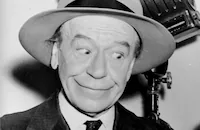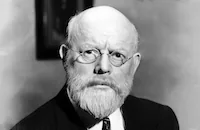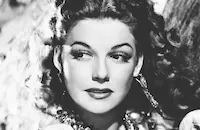Murder at the Vanities
Brief Synopsis
Cast & Crew
Mitchell Leisen
Carl Brisson
Victor Mclaglen
Jack Oakie
Kitty Carlisle
Dorothy Stickney
Film Details
Technical Specs

Synopsis
On opening night of "The Vanities," a music and dance review, the European star of the show, Eric Lander, learns from private investigator Sadie Evans that his ex-girl friend Rita Ross has stolen articles from his apartment, as he had suspected. Rita, a performer in the Vanities, is passionately jealous of Ann Ware because she is Eric's fiancée and the leading lady. Among the stolen items is a picture of Eric's mother, Elsie Singer, who is working as the wardrobe mistress of the show under the name of Helene Smith, although only Eric, Ann and their friend, Homer Boothby, know Elsie's true identity. Sadie informs Eric that Rita has communicated with Viennese police to determine the true identity of Elsie, who is wanted for a murder she committed in Vienna many years earlier. Rita now plots revenge against Eric. When several attempts are made on Ann's life before the show begins, producer Jack Ellery calls the police, and his friend, police chief Bill Murdock, arrives with some reinforcements. After a performance, Sadie is found dead in the flies over the stage, killed by a hatpin through her heart. Jack convinces Murdock to investigate without stopping the show. He is charmed by Rita, who leads him to suspect Elsie of the murder. When a machine gun with blanks is fired by Boothby at the end of the production number "The Rape of the Rhapsody" as part of the show, Rita is shot to death. A stagehand finds the murder weapon, which he gives to Jack, but Jack conceals it until Eric is identified as the owner. Still unaware that Rita is dead, Eric goes into her dressing room and is met by Norma Watson, Rita's beleagured maid who is infatuated with him. Norma gives him a letter to the Vienna police that Rita asked her to mail, and tells him that although she is aware of Elsie's true identity, she has no intention of exposing her. As Eric burns the letter, Murdock enters and arrests him for Rita's murder. Although he is handcuffed, Eric finishes the show, and Norma then prevents Murdock from taking him away. Norma reveals that Eric has always treated her with kindness and prevented several beatings at the hands of her mistress. Weary of Rita's brutality and hatefulness, Norma killed her in a fit of passion, inspired by the tempestuous music and machine gun fire. Norma also reveals that Rita killed Sadie, who had followed her up into the flies. Norma does not reveal Elsie's true identity and is arrested by Murdock, after which Eric and Ann promise to get the finest lawyer for her defense. Finally, Nancy, a showgirl who has been trying to get Jack's attention all night, reveals that she saw Rita steal a hat pin from wardrobe much earlier in the evening. With this final evidence, the case is closed, and Jack takes Nancy on a date.

Director

Mitchell Leisen
Cast
Carl Brisson

Victor Mclaglen

Jack Oakie

Kitty Carlisle
Dorothy Stickney
Gertrude Michael

Jessie Ralph
Chas. B. Middleton

Gail Patrick

Donald Meek

Toby Wing
Duke Ellington's Orchestra
Otto Hoffman
Charles Mcavoy
Beryl Wallace
Barbara Fritchie
Lona Andre
Colin Tapley
William Arnold
Arthur Rankin
Cecil Weston
Hal Greene
Teru Shimada
Roy Crane
Ted Oliver
Mildred Gover
Stanley Blystone
Mike Pat Donovan

Howard Mitchell
Betty Bethune

Clara Lou Sheridan
Gwenllian Gill
Evelyn Kelly
Wanda Perry
Marion Callahan
Dorothy Dawes
Laurie Shevlin
Ruth Hilliard
Blanche Mcdonald
Constance Jordan
Ernestine Anderson
Leda Nacova
Anya Taranda
Billie Huber
Winnie Flint
Virginia Davis
Crew
Larry Ceballos
Sam Coslow
Hans Dreier
Ernst Fegté
Joseph Gollomb
Earl Hayman
Sam Hellman
Arthur Johnston
Arthur Mayo
Leroy Prinz
Billy Shea
E. Lloyd Sheldon
Leo Tover
Carey Wilson

Film Details
Technical Specs

Quotes
Trivia
Notes
Opening credits read: "Paramount Presents Earl Carroll's Murder at the Vanities." The following information derives from the MPAA/PCA Collection at the AMPAS Library: In September 1933, synopses for Murder at the Vanities were submitted to the AMPP for their approval, followed by scripts beginning in January 1934. In a letter dated January 12, 1934 from Joseph I. Breen, director of the AMPP, to Paramount producer A. M. Botsford, Breen suggested revisions in order to comply with the Production Code: "As a general caution, we call your attention to the fact that, throughout the stage directions in the script, considerable stress is laid upon the almost-nudity of the girls. We assume that in production, you will take care that nothing offensive creeps in from this standpoint." Further suggestions referred to specific lines, including the following: "We suggest modifying the line 'Crawling out of the minister's night shirt'"; "The line 'Those dames has got some clues I'd like to work on'"; and "Go and rivet some panties on those cuties of yours"; all of which remain in the print viewed. Lyrics of the song "Marihuana" were submitted to the AMPP and accepted, though Breen was concerned that the song not be emphasized in the film and was assured by Paramount executive John Hammell "that the song would be carried along as a background melody to some action leading up to a murder. He has agreed to allow us to see the shot after it is completed, at which time we shall pass our final judgment."
In April 1934 Breen viewed the film, and although he expressed concern over the "possible censorship reaction" to the picture, it was deemed acceptable. In 1935, attention was called to the film again, as noted in a 15 July letter by Frederick L. Herron, Foreign Manager of the MPPDA: "The Department of State is very much worked up over a song which occurred in one of our pictures...called 'Sweet Marijuana Lull me to Sleep'....It seems that the United States is being viciously attacked in Geneva by the Opium Advisory Committee of the League of Nations because it does not stop the growth of the weed from which marijuana is made. The United States, as you probably know, has been one of the main objectors to the opium trade of the world....Any reference to [marijuana] in any of our pictures is considered in the same way that a reference to opium would be. The State Department has taken this up informally with me rather than to address our organization in a formal manner and I have written them that I would take the matter up with your office at once to see if we could not head off further references to this particular drug." Breen sent a copy of Herron's letter to John Hammell at Paramount, noting that "this unfortunate repercussion should serve to fortify us in this office in our belief that our first hunches are generally right, and that we should not allow ourselves to be argued out of our position too easily." Colonel Herron communicated again to Will H. Hays, president of the MPPDA, indicating that he had met with Mr. Stuart Fuller, a member of the Narcotics Division of the State Department regarding the song "Marihuana." In his 24 July letter, Herron states that he informed the State Department "that there was no idea of propaganda in the use of this word in the motion picture, that it was simply used for effect and I felt absolutely certain that the studios would be very glad to abandon any reference to Marijuana, just as they make no reference to opium, morphine or other narcotics."
On July 27, 1935, Botsford sent Hays a copy of the lyrics to "Marihuana:" "Soothe me with your caress/Sweet Marahuana/Marahuana/Help me in my distress/Sweet Marahuana, please do/You alone can bring my lover back to me/Even though I know it's only a fantasy/And then, put me to sleep/Sweet Marahuana/Marahuana." In his accompanying letter Botsford defends the studio's decision to include the song in the film: "There is, of course, no indication of the use of any narcotic nor are there any girls smoking cigarettes or anything to indicate that this is a song about narcotics. The song would be just as effective if, instead of the word Marahuana, we used the word Manuella....If the word Marahuana was not in the song there could be no possible connotation with any narcotic in any part of the song or scene, nor do we believe that it is evident to many thousands of people who do not know what marahuana is that this song has anything to do with narcotics....It was the opinion, probably ill-advised, of all concerned that there would be nothing to indicate an unfavorable reaction on the part of the public to this song." According to a letter written by Botsford on 14 Sep, "Paramount Pictures Studios issued orders to the Paramount New York office to inform all exchanges to eliminate the song "Marahuana" in all prints....The same elimination will be made in the original negative. This elimination is done under protest, as a matter of friendship and policy. It is not to be taken to indicate that anyone at Paramount agrees in any part with the thought that the song, as used in the picture, either deliberately or unconsciously conveys any effect whatsoever in connection with narcotics." The film was issued a certificate of approval. Breen later noted in a letter to Hays that the Code manual contained no specific reference to policy about the "non-medical use of narcotic drugs" in films. The sequence with the song "Marahuana" was included in the viewed print.
The profession of Jack Oakie's character "Jack Ellery" is never identified in the film, although it was mentioned that Ellery was a reporter before his affiliation with the Vanities show and reviews variously call him a press agent and stage manager. However, these remain unconfirmed. This film marked the feature film debut of singer-actress Kitty Carlisle (1910-2007), and the American film debut of Danish-born actor Carl Brisson (1893-1958). Earl Carroll produced his first "Vanities" in 1923, and subsequently wrote, staged, directed and produced ten more. According to a news item in Hollywood Reporter, Carroll contributed to direction and "art work" on the film. According to a modern source, director Mitchell Leisen appears as the orchestra leader in one scene.












